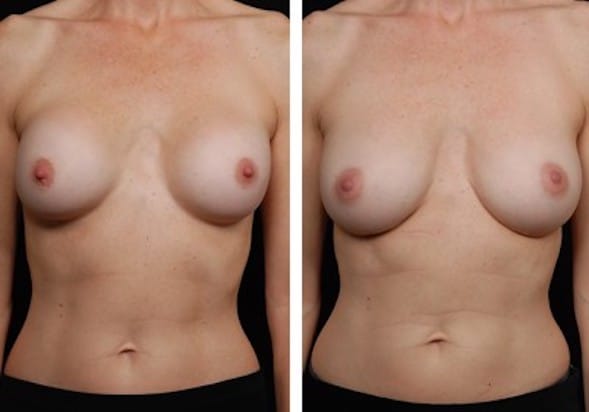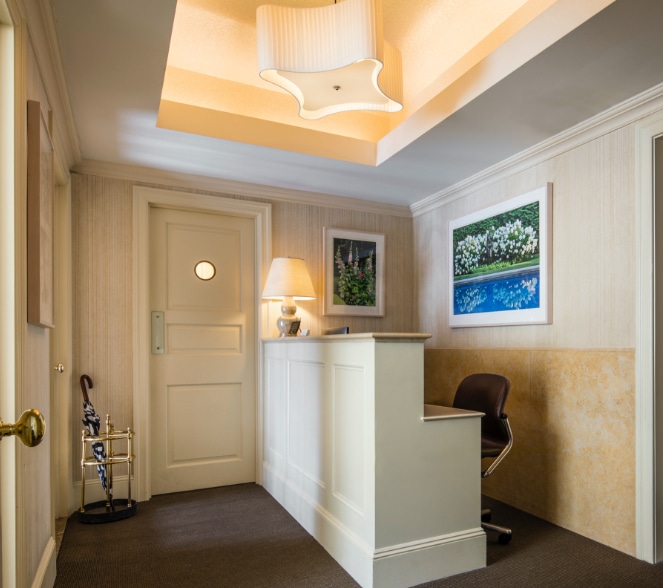The vast majority of women have successful breast augmentation surgery and are pleased with their results for decades. However some women are tempted to have a second procedure to make a good result even better. In other instances a problem may exist or develops over time that warrants additional surgery. An important goal is to have as few surgeries over a lifetime as possible. Below are scenarios that may or may not be valid reasons for considering more surgery.
My saline implants are ten years old. What do I do?
If the breasts look good and both are soft there is no need to change them. One of the beauties of saline implants is that if they do not deflate for ten years they will probably last another ten years, or even more. Even if minimal rippling is present but the overall result is excellent a change is not recommended. It is better to wait until one finally deflates, if it ever does.
My saline implants have ripples and I don’t like the way they feel. Should I change to silicone?
From 1992 to 2006 silicone implants were taken off the market in the United States by the FDA. Saline implants were the only type available for breast augmentation then. Most women having surgery during that period were and remain pleased with the results using saline implants. However, women who are very thin or had large implants placed may exhibit significant rippling on the side of the breasts with easily felt implants on the bottom of the breasts. If the breasts have remained soft and there is no intention to make them even larger then changing to silicone implants is a low risk option to eliminate rippling and easily palpable implants.
I like my breasts but want them bigger. Should I do it?
If you are happy with the results of your breast augmentation but just want more volume caution is urged when considering more surgery. The baseline dimensions of the breast in terms of width, the distance between the bottom of the areola and the crease under the breast (longer distance allows larger implants), and the amount of skin available all influence the maximum size implant that can be accommodated. To exceed what these dimensions allow may improve the effect in clothes but often at the cost of harmonious aesthetics when undressed.
Most women seeking a larger breast size need to increase by at least 100 cc, about half a cup size, to make it worth it. That said, implant sizes over 400 cc generally cause more problems over time such as bottoming out, among others. Unless you are 5’10” or taller implant sizes that begin with a “4” are usually not a good idea. Most importantly, if you have had a successful breast augmentation procedure, undergoing more surgery just for a size increase flirts with developing a problem that you do not have presently, and one that could lead to needing yet another procedure for correction. If you are mostly happy with what you have it is better not to go larger.
I had a great result but after three pregnancies it’s gone. What can I do?
Multiple pregnancies and breast feeding following breast augmentation can cause tissue atrophy and a deflated appearance to the breasts. If the implants have remained soft it is not complicated to place larger ones to fill out the skin and restore shape and tone. However, if the breasts have fallen more substantially, or the nipple position has drifted downward significantly, a lift with more noticeable scars may also be required to improve appearance.
My implants seem too big now. What’s the risk of making them smaller?
Sometimes many years following breast augmentation and perhaps due to some weight gain the breasts seem too large. Downsizing breast implants is usually easier than upsizing because typically less needs to be done on the inside. Furthermore, skin stress and the long term problems it may cause are reduced when going smaller. As long as the implants are soft to begin with this type of surgery is low risk despite requiring some adjustment to the implant pockets inside.
My breasts are firm and look bad. What are my options?
Capsular contracture refers to abnormal thickening of the scar layer around the implants inside. This process makes the breasts feel hard. This is a known risk of having breast implants and occurs on one or both sides without apparent cause in at least five percent of women (Figure 1). The implants ride up when this happens and the breast tissue seems loose and hangs below them. This problem is more favorable when only one side is affected because normal healing capability has been demonstrated on the unaffected side. Surgical correction is usually successful in these cases. When this process occurs on both sides it indicates a stronger biologic reaction to the implants. Surgical correction is less predictable and hardening commonly recurs in this situation. If the appearance is acceptable even though the breasts are both firm it is probably better to leave them alone. Taking them out altogether is rarely a good option unless there is chronic pain associated with the condition.

OF THE MUSCLE AND HAS DEVELOPED CAPSULES ON BOTH SIDES (LEFT).
NEW SILICONE IMPLANTS WERE PLACED IN A FRESH POCKET UNDER
THE MUSCLE (RIGHT).
My implants don’t seem to be in the right place. Can that be fixed?
Sometimes one implant is either higher or lower than the other, sometimes one or both may seem to be too far out to the sides when lying down, or they both may have stretched the skin and sit too low. All of these conditions are treatable with additional surgery and have a high success rate, particularly if no other co-existing problems such as capsular contracture are present.
Do I have too many goals for repeat surgery?
It is best to limit the goals when having repeat surgery. Correction of capsular contracture, repositioning one or both implants, and changing implant size all at once, for example, makes the procedure longer, more complex, and with a higher chance of either developing a complication or inadvertently causing a new problem. Keeping it simple is the best policy, focusing on only the most essential goals.





